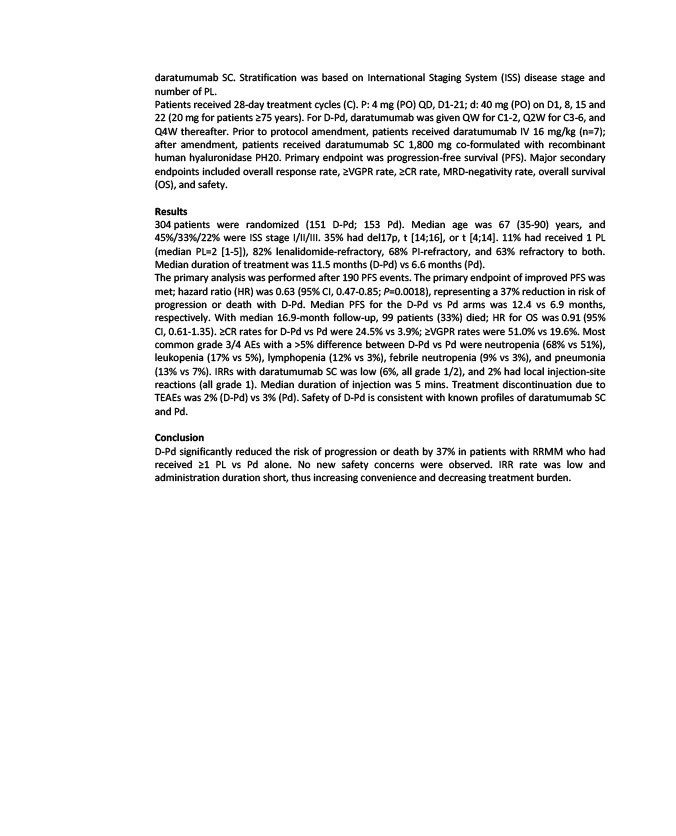
daratumumab SC. Stratification was based on International Staging System (ISS) disease stage and
number of PL.
Patients received 28-day treatment cycles (C). P: 4 mg (PO) QD, D1-21; d: 40 mg (PO) on D1, 8, 15 and
22 (20 mg for patients ≥75 years). For D-Pd, daratumumab was given QW for C1-2, Q2W for C3-6, and
Q4W thereafter. Prior to protocol amendment, patients received daratumumab IV 16 mg/kg (n=7);
after amendment, patients received daratumumab SC 1,800 mg co-formulated with recombinant
human hyaluronidase PH20. Primary endpoint was progression-free survival (PFS). Major secondary
endpoints included overall response rate, ≥VGPR rate, ≥CR rate, MRD-negativity rate, overall survival
(OS), and safety.
Results
304 patients were randomized (151 D-Pd; 153 Pd). Median age was 67 (35-90) years, and
45%/33%/22% were ISS stage I/II/III. 35% had del17p, t 14;16, or t 4;14. 11% had received 1 PL
(median PL=2 1-5), 82% lenalidomide-refractory, 68% PI-refractory, and 63% refractory to both.
Median duration of treatment was 11.5 months (D-Pd) vs 6.6 months (Pd).
The primary analysis was performed after 190 PFS events. The primary endpoint of improved PFS was
met; hazard ratio (HR) was 0.63 (95% CI, 0.47-0.85; P=0.0018), representing a 37% reduction in risk of
progression or death with D-Pd. Median PFS for the D-Pd vs Pd arms was 12.4 vs 6.9 months,
respectively. With median 16.9-month follow-up, 99 patients (33%) died; HR for OS was 0.91 (95%
CI, 0.61-1.35). ≥CR rates for D-Pd vs Pd were 24.5% vs 3.9%; ≥VGPR rates were 51.0% vs 19.6%. Most
common grade 3/4 AEs with a >5% difference between D-Pd vs Pd were neutropenia (68% vs 51%),
leukopenia (17% vs 5%), lymphopenia (12% vs 3%), febrile neutropenia (9% vs 3%), and pneumonia
(13% vs 7%). IRRs with daratumumab SC was low (6%, all grade 1/2), and 2% had local injection-site
reactions (all grade 1). Median duration of injection was 5 mins. Treatment discontinuation due to
TEAEs was 2% (D-Pd) vs 3% (Pd). Safety of D-Pd is consistent with known profiles of daratumumab SC
and Pd.
Conclusion
D-Pd significantly reduced the risk of progression or death by 37% in patients with RRMM who had
received ≥1 PL vs Pd alone. No new safety concerns were observed. IRR rate was low and
administration duration short, thus increasing convenience and decreasing treatment burden.